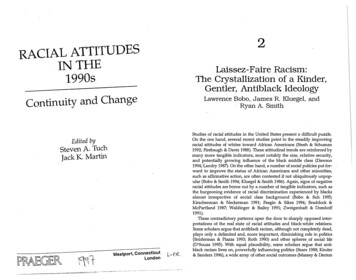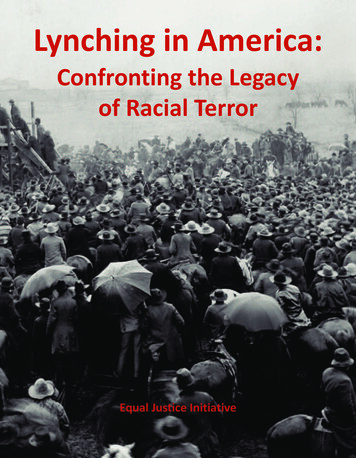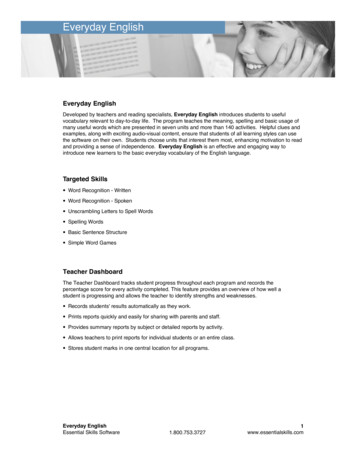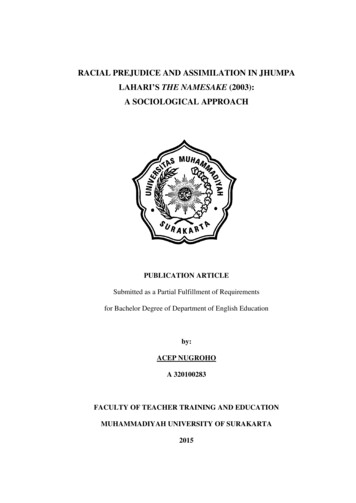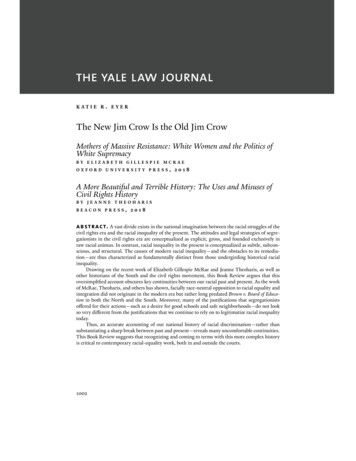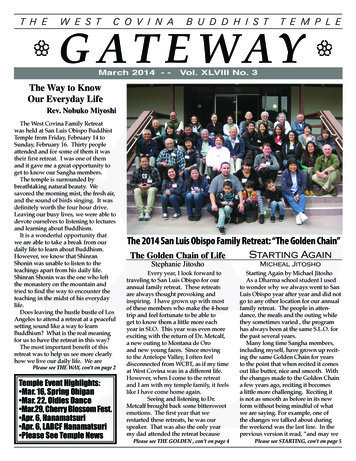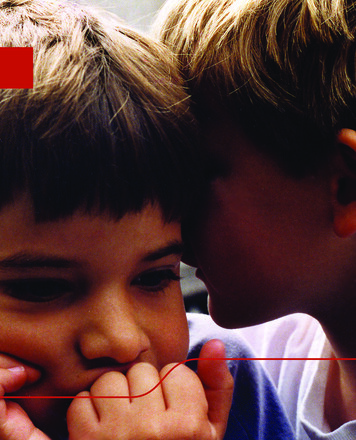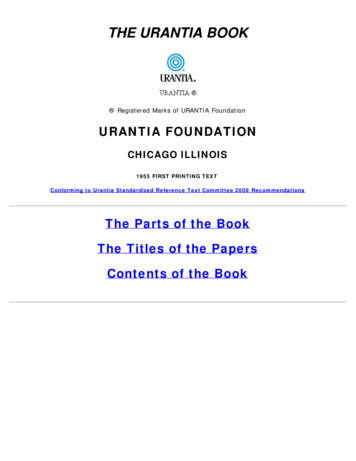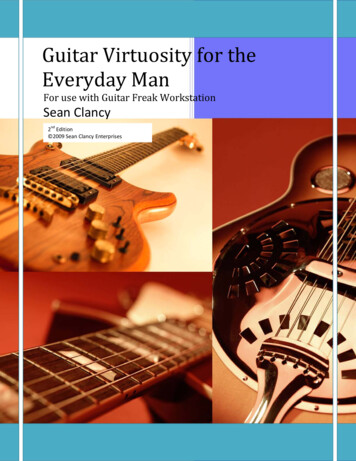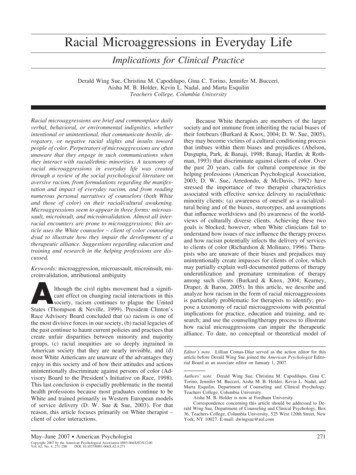
Transcription
Racial Microaggressions in Everyday LifeImplications for Clinical PracticeDerald Wing Sue, Christina M. Capodilupo, Gina C. Torino, Jennifer M. Bucceri,Aisha M. B. Holder, Kevin L. Nadal, and Marta EsquilinTeachers College, Columbia UniversityRacial microaggressions are brief and commonplace dailyverbal, behavioral, or environmental indignities, whetherintentional or unintentional, that communicate hostile, derogatory, or negative racial slights and insults towardpeople of color. Perpetrators of microaggressions are oftenunaware that they engage in such communications whenthey interact with racial/ethnic minorities. A taxonomy ofracial microaggressions in everyday life was createdthrough a review of the social psychological literature onaversive racism, from formulations regarding the manifestation and impact of everyday racism, and from readingnumerous personal narratives of counselors (both Whiteand those of color) on their racial/cultural awakening.Microaggressions seem to appear in three forms: microassault, microinsult, and microinvalidation. Almost all interracial encounters are prone to microaggressions; this article uses the White counselor – client of color counselingdyad to illustrate how they impair the development of atherapeutic alliance. Suggestions regarding education andtraining and research in the helping professions are discussed.Keywords: microaggression, microassault, microinsult, microinvalidation, attributional ambiguityAlthough the civil rights movement had a significant effect on changing racial interactions in thissociety, racism continues to plague the UnitedStates (Thompson & Neville, 1999). President Clinton’sRace Advisory Board concluded that (a) racism is one ofthe most divisive forces in our society, (b) racial legacies ofthe past continue to haunt current policies and practices thatcreate unfair disparities between minority and majoritygroups, (c) racial inequities are so deeply ingrained inAmerican society that they are nearly invisible, and (d)most White Americans are unaware of the advantages theyenjoy in this society and of how their attitudes and actionsunintentionally discriminate against persons of color (Advisory Board to the President’s Initiative on Race, 1998).This last conclusion is especially problematic in the mentalhealth professions because most graduates continue to beWhite and trained primarily in Western European modelsof service delivery (D. W. Sue & Sue, 2003). For thatreason, this article focuses primarily on White therapist –client of color interactions.May–June 2007 American PsychologistCopyright 2007 by the American Psychological Association 0003-066X/07/ 12.00Vol. 62, No. 4, 271–286DOI: 10.1037/0003-066X.62.4.271Because White therapists are members of the largersociety and not immune from inheriting the racial biases oftheir forebears (Burkard & Knox, 2004; D. W. Sue, 2005),they may become victims of a cultural conditioning processthat imbues within them biases and prejudices (Abelson,Dasgupta, Park, & Banaji, 1998; Banaji, Hardin, & Rothman, 1993) that discriminate against clients of color. Overthe past 20 years, calls for cultural competence in thehelping professions (American Psychological Association,2003; D. W. Sue, Arredondo, & McDavis, 1992) havestressed the importance of two therapist characteristicsassociated with effective service delivery to racial/ethnicminority clients: (a) awareness of oneself as a racial/cultural being and of the biases, stereotypes, and assumptionsthat influence worldviews and (b) awareness of the worldviews of culturally diverse clients. Achieving these twogoals is blocked, however, when White clinicians fail tounderstand how issues of race influence the therapy processand how racism potentially infects the delivery of servicesto clients of color (Richardson & Molinaro, 1996). Therapists who are unaware of their biases and prejudices mayunintentionally create impasses for clients of color, whichmay partially explain well-documented patterns of therapyunderutilization and premature termination of therapyamong such clients (Burkard & Knox, 2004; Kearney,Draper, & Baron, 2005). In this article, we describe andanalyze how racism in the form of racial microaggressionsis particularly problematic for therapists to identify; propose a taxonomy of racial microaggressions with potentialimplications for practice, education and training, and research; and use the counseling/therapy process to illustratehow racial microaggressions can impair the therapeuticalliance. To date, no conceptual or theoretical model ofEditor’s note. Lillian Comas-Dı́az served as the action editor for thisarticle before Derald Wing Sue joined the American Psychologist Editorial Board as an associate editor on January 1, 2007.Authors’ note. Derald Wing Sue, Christina M. Capodilupo, Gina C.Torino, Jennifer M. Bucceri, Aisha M. B. Holder, Kevin L. Nadal, andMarta Esquilin, Department of Counseling and Clinical Psychology,Teachers College, Columbia University.Aisha M. B. Holder is now at Fordham University.Correspondence concerning this article should be addressed to Derald Wing Sue, Department of Counseling and Clinical Psychology, Box36, Teachers College, Columbia University, 525 West 120th Street, NewYork, NY 10027. E-mail: dwingsue@aol.com271
Derald WingSueracial microaggressions has been proposed to explain theirimpact on the therapeutic process.The Changing Face of RacismIn recent history, racism in North America has undergonea transformation, especially after the post– civil rights erawhen the conscious democratic belief in equality for groupsof color directly clashed with the long history of racism inthe society (Jones, 1997; Thompson & Neville, 1999). Themore subtle forms of racism have been labeled modernracism (McConahay, 1986), symbolic racism (Sears, 1988),and aversive racism (Dovidio, Gaertner, Kawakami, &Hodson, 2002). All three explanations of contemporaryracism share commonalities. They emphasize that racism(a) is more likely than ever to be disguised and covert and(b) has evolved from the “old fashioned” form, in whichovert racial hatred and bigotry is consciously and publiclydisplayed, to a more ambiguous and nebulous form that ismore difficult to identify and acknowledge.It appears that modern and symbolic racism are mostclosely associated with political conservatives, who disclaim personal bigotry by strong and rigid adherence totraditional American values (individualism, self-reliance,hard work, etc.), whereas aversive racism is more characteristic of White liberals (Dovidio & Gaertner, 1996, 2000).Aversive racists, according to these researchers, arestrongly motivated by egalitarian values as well as antiminority feelings. Their egalitarian values operate on a conscious level, while their antiminority feelings are less conscious and generally covert (DeVos & Banaji, 2005). Insome respects, these three forms of racism can be orderedalong a continuum; aversive racists are the least consciously negative, followed by modern and symbolic rac272ists, who are somewhat more prejudiced, and finally byold-fashioned biological racists (Nelson, 2006).Although much has been written about contemporaryforms of racism, many studies in health care (Smedley &Smedley, 2005), education (Gordon & Johnson, 2003),employment (Hinton, 2004), mental health (Burkard &Knox, 2004), and other social settings (Sellers & Shelton,2003) indicate the difficulty of describing and definingracial discrimination that occurs via “aversive racism” or“implicit bias”; these types of racism are difficult to identify, quantify, and rectify because of their subtle, nebulous,and unnamed nature. Without an adequate classification orunderstanding of the dynamics of subtle racism, it willremain invisible and potentially harmful to the well-being,self-esteem, and standard of living of people of color (U.S.Department of Health and Human Services, 2001). Ironically, it has been proposed that the daily common experiences of racial aggression that characterize aversive racismmay have significantly more influence on racial anger,frustration, and self-esteem than traditional overt forms ofracism (Solórzano, Ceja, & Yosso, 2000). Furthermore, theinvisible nature of acts of aversive racism prevents perpetrators from realizing and confronting (a) their own complicity in creating psychological dilemmas for minoritiesand (b) their role in creating disparities in employment,health care, and education.The Manifestation of RacialMicroaggressionsIn reviewing the literature on subtle and contemporaryforms of racism, we have found the term “racial microaggressions” to best describe the phenomenon in its everydayoccurrence. First coined by Pierce in 1970, the term refersto “subtle, stunning, often automatic, and non-verbal ex-Christina M.CapodilupoMay–June 2007 American Psychologist
Gina C.Torinochanges which are ‘put downs’” (Pierce, Carew, PierceGonzalez, & Willis, 1978, p. 66). Racial microaggressionshave also been described as “subtle insults (verbal, nonverbal, and/or visual) directed toward people of color, oftenautomatically or unconsciously” (Solórzano et al., 2000).Simply stated, microaggressions are brief, everyday exchanges that send denigrating messages to people of colorbecause they belong to a racial minority group. In the worldof business, the term “microinequities” is used to describethe pattern of being overlooked, underrespected, and devalued because of one’s race or gender. Microaggressionsare often unconsciously delivered in the form of subtlesnubs or dismissive looks, gestures, and tones. These exchanges are so pervasive and automatic in daily conversations and interactions that they are often dismissed andglossed over as being innocent and innocuous. Yet, asindicated previously, microaggressions are detrimental topersons of color because they impair performance in amultitude of settings by sapping the psychic and spiritualenergy of recipients and by creating inequities (Franklin,2004; D. W. Sue, 2004).There is an urgent need to bring greater awareness andunderstanding of how microaggressions operate, their numerous manifestations in society, the type of impact theyhave on people of color, the dynamic interaction betweenperpetrator and target, and the educational strategiesneeded to eliminate them. Our attempt to define and propose a taxonomy of microaggressions is grounded in several lines of empirical and experiential evidence in theprofessional literature and in personal narratives.First, the work by psychologists on aversive racism(Dovidio & Gaertner, 1996; Dovidio et al., 2002), studiessuggesting the widespread existence of dissociation between implicit and explicit social stereotyping (Abelson etMay–June 2007 American Psychologistal., 1998; Banaji et al., 1993; DeVos & Banaji, 2005), theattributional ambiguity of everyday racial discrimination(Crocker & Major, 1989), the daily manifestations of racism in many arenas of life (Plant & Peruche, 2005; Sellers& Shelton, 2003; Vanman, Saltz, Nathan, & Warren,2004), and multiple similarities between microaggressiveincidents and items that comprise measures of race-relatedstress/perceived discrimination toward Black Americans(Brondolo et al., 2005; Klonoff & Landrine, 1999; Utsey &Ponterotto, 1996) and Asian Americans (Liang, Li, & Kim,2004) all seem to lend empirical support to the concept ofracial microaggressions. Second, numerous personal narratives and brief life stories on race written by White psychologists and psychologists of color provide experientialevidence for the existence of racial microaggressions ineveryday life (American Counseling Association, 1999;Conyne & Bemak, 2005; Ponterotto, Casas, Suzuki, &Alexander, 2001). Our analysis of the life experiences ofthese individuals and the research literature in social andcounseling psychology led us to several conclusions: (a)The personal narratives were rich with examples and incidents of racial microaggressions, (b) the formulation ofmicroaggressions was consistent with the research literature, and (c) racial microaggressions seemed to manifestthemselves in three distinct forms.Forms of Racial MicroaggressionsRacial microaggressions are brief and commonplace dailyverbal, behavioral, and environmental indignities, whetherintentional or unintentional, that communicate hostile, derogatory, or negative racial slights and insults to the targetperson or group. They are not limited to human encountersalone but may also be environmental in nature, as when aperson of color is exposed to an office setting that unin-Jennifer M.Bucceri273
Aisha M. B.Holderracial heritage or identity. Microinsults represent subtlesnubs, frequently unknown to the perpetrator, but clearlyconvey a hidden insulting message to the recipient of color.When a White employer tells a prospective candidate ofcolor “I believe the most qualified person should get thejob, regardless of race” or when an employee of color isasked “How did you get your job?”, the underlying message from the perspective of the recipient may be twofold:(a) People of color are not qualified, and (b) as a minoritygroup member, you must have obtained the positionthrough some affirmative action or quota program and notbecause of ability. Such statements are not necessarilyaggressions, but context is important. Hearing these statements frequently when used against affirmative actionmakes the recipient likely to experience them as aggressions. Microinsults can also occur nonverbally, as when aWhite teacher fails to acknowledge students of color in theclassroom or when a White supervisor seems distractedduring a conversation with a Black employee by avoidingeye contact or turning away (Hinton, 2004). In this case,the message conveyed to persons of color is that theircontributions are unimportant.Microinvalidationtentionally assails his or her racial identity (Gordon &Johnson, 2003; D. W. Sue, 2003). For example, one’s racialidentity can be minimized or made insignificant through thesheer exclusion of decorations or literature that representsvarious racial groups. Three forms of microaggressions canbe identified: microassault, microinsult, and microinvalidation.MicroassaultA microassault is an explicit racial derogation characterized primarily by a verbal or nonverbal attack meant to hurtthe intended victim through name-calling, avoidant behavior, or purposeful discriminatory actions. Referring tosomeone as “colored” or “Oriental,” using racial epithets,discouraging interracial interactions, deliberately serving aWhite patron before someone of color, and displaying aswastika are examples. Microassaults are most similar towhat has been called “old fashioned” racism conducted onan individual level. They are most likely to be consciousand deliberate, although they are generally expressed inlimited “private” situations (micro) that allow the perpetrator some degree of anonymity. In other words, peopleare likely to hold notions of minority inferiority privatelyand will only display them publicly when they (a) losecontrol or (b) feel relatively safe to engage in a microassault. Because we have chosen to analyze the unintentionaland unconscious manifestations of microaggressions, microassaults are not the focus of our article. It is important tonote, however, that individuals can also vary in the degreeof conscious awareness they show in the use of the following two forms of microaggressions.Microinvalidations are characterized by communicationsthat exclude, negate, or nullify the psychological thoughts,feelings, or experiential reality of a person of color. WhenAsian Americans (born and raised in the United States) arecomplimented for speaking good English or are repeatedlyasked where they were born, the effect is to negate theirU.S. American heritage and to convey that they are perpetual foreigners. When Blacks are told that “I don’t seecolor” or “We are all human beings,” the effect is to negatetheir experiences as racial/cultural beings (Helms, 1992).MicroinsultA microinsult is characterized by communications thatconvey rudeness and insensitivity and demean a person’s274Kevin L.NadalMay–June 2007 American Psychologist
with a single row of seats on one side and double seats on theother. As the plane was only sparsely populated, we were told bythe flight attendant (White) that we could sit anywhere, so we satat the front, across the aisle from one another. This made it easyfor us to converse and provided a larger comfortable space on asmall plane for both of us. As the attendant was about to close thehatch, three White men in suits entered the plane, were informedthey could sit anywhere, and promptly seated themselves in frontof us. Just before take-off, the attendant proceeded to close alloverhead compartments and seemed to scan the plane with hereyes. At that point she approached us, leaned over, interrupted ourconversation, and asked if we would mind moving to the back ofthe plane. She indicated that she needed to distribute weight onthe plane evenly.Both of us (passengers of color) had similar negative reactions.First, balancing the weight on the plane seemed reasonable, butwhy were we being singled out? After all, we had boarded firstand the three White men were the last passengers to arrive. Whywere they not being asked to move? Were we being singled outbecause of our race? Was this just a random event with no racialovertones? Were we being oversensitive and petty?MartaEsquilinWhen a Latino couple is given poor service at a restaurantand shares their experience with White friends, only to betold “Don’t be so oversensitive” or “Don’t be so petty,” theracial experience of the couple is being nullified and itsimportance is being diminished.We have been able to identify nine categories ofmicroaggressions with distinct themes: alien in one’s ownland, ascription of intelligence, color blindness, criminality/assumption of criminal status, denial of individual racism, myth of meritocracy, pathologizing cultural values/communication styles, second-class status, and environmentalinvalidation. Table 1 provides samples of comments or situations that may potentially be classified as racial microaggressions and their accompanying hidden assumptions and messages. Figure 1 visually presents the three large classes ofmicroaggressions, the classification of the themes under eachcategory, and their relationship to one another.The experience of a racial microaggression has majorimplications for both the perpetrator and the target person.It creates psychological dilemmas that unless adequatelyresolved lead to increased levels of racial anger, mistrust,and loss of self-esteem for persons of color; prevent Whitepeople from perceiving a different racial reality; and createimpediments to harmonious race-relations (Spanierman &Heppner, 2004; Thompson & Neville, 1999).The Invisibility and Dynamics ofRacial MicroaggressionsThe following real-life incident illustrates the issues ofinvisibility and the disguised problematic dynamics of racial microaggressions.I [Derald Wing Sue, the senior author, an Asian American]recently traveled with an African American colleague on a planeflying from New York to Boston. The plane was a small “hopper”May–June 2007 American PsychologistAlthough we complied by moving to the back of the plane, bothof us felt resentment, irritation, and anger. In light of our everydayracial experiences, we both came to the same conclusion: Theflight attendant had treated us like second-class citizens becauseof our race. But this incident did not end there. While I kepttelling myself to drop the matter, I could feel my blood pressurerising, heart beating faster, and face flush with anger. When theattendant walked back to make sure our seat belts were fastened,I could not contain my anger any longer. Struggling to controlmyself, I said to her in a forced calm voice: “Did you know thatyou asked two passengers of color to step to the rear of the ‘bus’”?For a few seconds she said nothing but looked at me with ahorrified expression. Then she said in a righteously indignanttone, “Well, I have never been accused of that! How dare you? Idon’t see color! I only asked you to move to balance the plane.Anyway, I was only trying to give you more space and greaterprivacy.”Attempts to explain my perceptions and feelings only generatedgreater defensiveness from her. For every allegation I made, sheseemed to have a rational reason for her actions. Finally, shebroke off the conversation and refused to talk about the incidentany longer. Were it not for my colleague who validated myexperiential reality, I would have left that encounter wonderingwhether I was correct or incorrect in my perceptions. Nevertheless, for the rest of the flight, I stewed over the incident and it lefta sour taste in my mouth.The power of racial microaggressions lies in theirinvisibility to the perpetrator and, oftentimes, the recipient(D. W. Sue, 2005). Most White Americans experiencethemselves as good, moral, and decent human beings whobelieve in equality and democracy. Thus, they find it difficult to believe that they possess biased racial attitudes andmay engage in behaviors that are discriminatory (D. W.Sue, 2004). Microaggressive acts can usually be explainedaway by seemingly nonbiased and valid reasons. For therecipient of a microaggression, however, there is alwaysthe nagging question of whether it really happened(Crocker & Major, 1989). It is difficult to identify a microaggression, especially when other explanations seemplausible. Many people of color describe a vague feeling275
Table 1Examples of Racial MicroaggressionsThemeMicroaggressionMessageAlien in own landWhen Asian Americans and LatinoAmericans are assumed to beforeign-born“Where are you from?”“Where were you born?”“You speak good English.”A person asking an Asian American toteach them words in their nativelanguageYou are not American.Ascription of intelligenceAssigning intelligence to a personof color on the basis of their race“You are a credit to your race.”People of color are generally not asintelligent as Whites.It is unusual for someone of your raceto be intelligent.All Asians are intelligent and good inmath/sciences.You are a foreigner.“You are so articulate.”Asking an Asian person to help with amath or science problemColor blindnessStatements that indicate that aWhite person does not want toacknowledge race“When I look at you, I don’t see color.”“America is a melting pot.”“There is only one race, the human race.”Denying a person of color’s racial/ethnic experiences.Assimilate/acculturate to thedominant culture.Denying the individual as a racial/cultural being.Criminality/assumption of criminalstatusA person of color is presumed to bedangerous, criminal, or devianton the basis of their raceA White man or woman clutching theirpurse or checking their wallet as aBlack or Latino approaches or passesA store owner following a customer ofcolor around the storeA White person waits to ride the nextelevator when a person of color is on itYou are a criminal.Denial of individual racismA statement made when Whitesdeny their racial biases“I’m not racist. I have several Blackfriends.”“As a woman, I know what you gothrough as a racial minority.”I am immune to racism because Ihave friends of color.Your racial oppression is no differentthan my gender oppression. I can’tbe a racist. I’m like you.Myth of meritocracyStatements which assert that racedoes not play a role in lifesuccesses“I believe the most qualified person shouldget the job.”“Everyone can succeed in this society, ifthey work hard enough.”People of color are given extra unfairbenefits because of their race.People of color are lazy and/orincompetent and need to workharder.Pathologizing cultural values/communication stylesThe notion that the values andcommunication styles of thedominant/White culture are idealAsking a Black person: “Why do youhave to be so loud/animated? Just calmdown.”To an Asian or Latino person: “Why areyou so quiet? We want to know whatyou think. Be more verbal.” “Speak upmore.”Dismissing an individual who brings uprace/culture in work/school settingAssimilate to dominant culture.Person of color mistaken for a serviceworkerPeople of color are servants toWhites. They couldn’t possiblyoccupy high-status positions.You are likely to cause trouble and/or travel to a dangerousneighborhood.Second-class citizenOccurs when a White person isgiven preferential treatment as aconsumer over a person of color276Having a taxi cab pass a person of colorand pick up a White passengerYou are going to steal/ You arepoor/ You do not belong.You are dangerous.Leave your cultural baggage outside.May–June 2007 American Psychologist
Table 1 (continued)ThemeMicroaggressionMessageSecond-class citizen (continued)Occurs when a White person isgiven preferential treatment as aconsumer over a person of color(continued)Being ignored at a store counter asattention is given to the White customerbehind you“You people . . . ”Whites are more valued customersthan people of color.Environmental microaggressionsMacro-level microaggressions,which are more apparent onsystemic and environmental levelsA college or university with buildings thatare all named after White heterosexualupper class malesTelevision shows and movies that featurepredominantly White people, withoutrepresentation of people of colorOvercrowding of public schools incommunities of colorOverabundance of liquor stores incommunities of colorYou don’t belong/You won’t succeedhere. There is only so far you cango.You are an outsider/You don’t exist.that they have been attacked, that they have been disrespected, or that something is not right (Franklin, 2004; Reid& Radhakrishnan, 2003). In some respects, people of colormay find an overt and obvious racist act easier to handlethan microaggressions that seem vague or disguised (Solórzano et al., 2000). The above incident reveals howmicroaggressions operate to create psychological dilemmasfor both the White perpetrator and the person of color. Foursuch dilemmas are particularly noteworthy for everyone tounderstand.Dilemma 1: Clash of Racial RealitiesThe question we pose is this: Did the flight attendantengage in a microaggression or did the senior author andhis colleague simply misinterpret the action? Studies indicate that the racial perceptions of people of color differmarkedly from those of Whites (Jones, 1997; Harris Pollcommissioned by the National Conference of Christiansand Jews, 1992). In most cases, White Americans tend tobelieve that minorities are doing better in life, that discrimination is on the decline, that racism is no longer a significant factor in the lives of people of color, and that equalityhas been achieved. More important, the majority of Whitesdo not view themselves as racist or capable of racist behavior.Minorities, on the other hand, perceive Whites as (a)racially insensitive, (b) unwilling to share their position andwealth, (c) believing they are superior, (d) needing tocontrol everything, and (e) treating them poorly because oftheir race. People of color believe these attributes arereenacted everyday in their interpersonal interactions withWhites, oftentimes in the form of microaggressions (Solórzano et al., 2000). For example, it was found that 96% ofAfrican Americans reported experiencing racial discrimination in a one-year period (Klonoff & Landrine, 1999),and many incidents involved being mistaken for a serviceMay–June 2007 American PsychologistYou don’t belong. You are a lesserbeing.People of color don’t/shouldn’t valueeducation.People of color are deviant.worker, being ignored, given poor service, treated rudely,or experiencing strangers acting fearful or intimidatedwhen around them (Sellers & Shelton, 2003).Dilemma 2: The Invisibility of UnintentionalExpressions of BiasThe interaction between the senior author and the flightattendant convinced him that she was sincere in her beliefthat she had acted in good faith without racial bias. Heractions and their meaning were invisible to her. It was clearthat she was stunned that anyone would accuse her of suchdespicable actions. After all, in her mind, she acted withonly the best of intentions: to distribute the weight evenlyon the plane for safety reasons and to give two passengersgreater privacy and space. She felt betrayed that her goodintentions were being questioned. Yet considerable empirical evidence exists showing that racial microaggressionsbecome automatic because of cultural conditioning and thatthey may become connected neurologically with the processing of emotions that surround prejudice (Abelson et al.,1998). Several investigators have found, for example, thatlaw enforcement officers in laboratory experiments will firetheir guns more often at Black criminal suspects than Whiteones (Plant & Peruche, 2005), and Afrocentric featurestend to result in longer prison terms (Blair, Judd, & Chapleau, 2004). In all cases, these law enforcement officialshad no conscious awareness that they responded differentlyon the basis of race.Herein lies a major dilemma. How does one prove thata microaggression has occurred? What makes our beliefthat the flight attendant acted in a biased manner any moreplausible than her conscious belief that it was generated foranother reason? If she did act out of hidden and unconscious bias, how do we make her aware of it? Socialpsychological research tends to confirm the existence ofunconscious racial biases in well-intentioned Whites, that277
Figure 1Categories of and Relationships Among Racial MicroaggressionsRacial MicroaggressionsCommonplace verbal or behavioral indignities, whether intentional or unintentional,which communicate hostile, derogatory, or negative racial slights and insults.MicroinsultMicroassault(Often Unconscious)(Often Conscious)(Often Unconscious)Explicit racial derogations characterizedprimarily by a violent verbal ornonverbal atta
racial microaggressions in everyday life was created through a review of the social psychological literature on aversive racism, from formulations regarding the manifes-tation and impact of everyday racism, and from reading numerous personal narratives of counselors (both Whit
